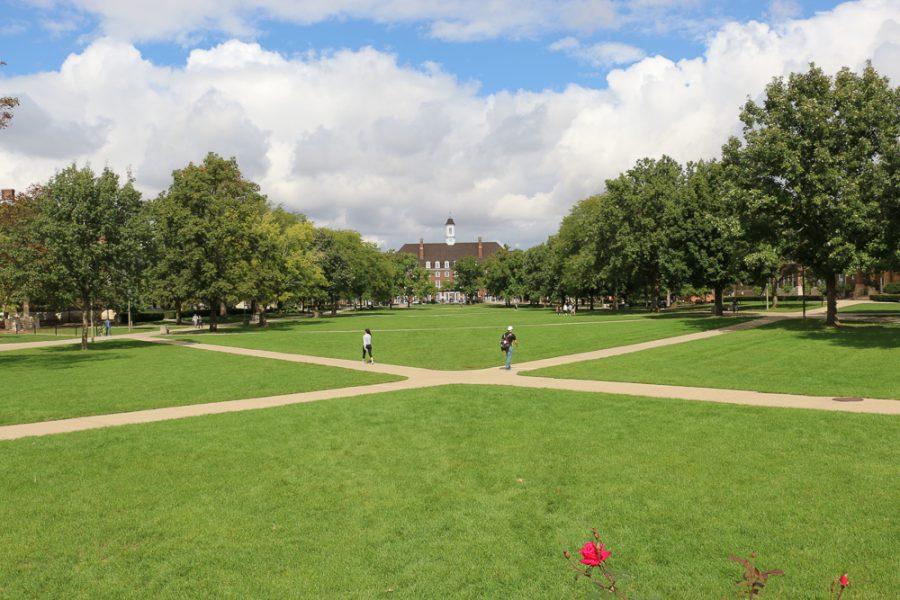Percentage of University students from underrepresented groups below peer median
The percentage of underrepresented students at the University remains lower than the peer median.
Mar 23, 2017
With an international population of over 10,000, the University boasts one of the highest percentages of international students in the country at nearly 24 percent. The percentage of students from underrepresented groups, however, remains below the median of the University’s peer group.
Of the three schools in the University of Illinois system, the Urbana-Champaign location is the only campus in which this is the case.
“There’s a huge international population, but then you go into other aspects [of diversity] like Black or Latinx, and that population is very slim still,” said Julius Adams, junior in FAA.
Underrepresented groups, as defined by the Board of Trustees, include Black, Hispanic, American Indian, Native Hawaiian/Other Pacific Islander and multi-racial students.
According to the Division of Management Information demographics report, African Americans represent a mere 5.16 percent of the student body, Hispanics 8.78 percent, American Indian 0.08 percent, and Native Hawaiian/Pacific Islander 0.06 percent.
Get The Daily Illini in your inbox!
Altogether, about 17 percent of the student body is made up of underrepresented groups. This is about 5 points lower than the median percentage of the University’s peers, which includes UCLA, UT-Austin, and University of Michigan.
“It’s noticeable,” Adams said. “Especially in fields like engineering, but even in music, there’s not a large African American population.”
However, Associate Chancellor for Public Affairs Robin Kaler said there are many factors that contribute to the University’s low percentage of underrepresented students.
“It’s easier to have a higher percentage of underrepresented students if you are willing for your overall class to be small,” Kaler said, “but Illinois affects the lives of more students.”
While the University’s percentage of underrepresented students falls below the peer median, it ranks third among its peers for the number of underrepresented students.
“The only schools [in the peer group] with more underrepresented students than Illinois are UCLA and UT-Austin,” Kaler said. “Both are in areas with large numbers of Hispanic students, and they do indeed enroll many more Hispanic students than Illinois.”
Still, the University’s percentage of underrepresented students is seen as an area for improvement, and campus units like the Office of Admissions and the Office of Inclusion and Intercultural Relations are working to address the issue.
According to a report from the Office of Enrollment Management, the University has created the Chancellor’s Access Grant, an access-oriented scholarship for Illinois residents from underrepresented groups.
The report also details the University’s Peer Recruitment Program, which sends University students to speak with potential students from Chicago-area high schools, including William Howard Taft High School and Instituto Health Sciences Career Academy.
Culture Houses such as BNAAC, La Casa Cultural Latina and Native American House (NAH) also work to reach out to underrepresented communities as well as provide services for currently enrolled underrepresented students.
According to Stephens, one of the outreach efforts from BNAAC is the Shelley Ambassadors program, which works with local school districts for “the strategic recruitment and outreach to African American students.”
“We have our student representatives have conversations with the incoming potential students,” said Stephens. “They can ask questions of what the student experience is like, and we talk about our programs and services that we provide.”
Jamie Singson, director of NAH, described his organization’s outreach efforts in conjunction with a federal grant program for Native American students in the Chicago area called Title VII.
“We work with the Chicago community to help students see college as accessible and attainable,” said Singson. “One of the things we’ve learned from working with students is that when they come to campus and visualize being on campus, they’re more likely to see it as a possibility.”
While the percentage of underrepresented students may be low, the number, at least for Latinx students, is on the rise.
As for current and incoming students, the Cultural Houses also has programs aimed at retention.
A point of focus for both La Casa and NAH is new student orientation.
Both Houses have an early move in program which allows incoming freshmen to tour the campus before most students arrive.
“[The program] helps them identify where their classes are going to be,” said Singson, “and talk about the politics as well so that they’re not blindsided by something maybe they wouldn’t be aware of if they hadn’t gone through orientation.”
Despite a low percentage of underrepresented students, programs aimed at retention seem to be having a positive effect.
A presentation before the Board of Trustees in November 2016 indicated that the University graduated 58 percent of its 2012 underrepresented freshmen cohort—a higher percent compared to the peer median.
“It’s important to make sure that the needs of the [admitted] students are met so that they can not just be admitted but also graduate,” Mena said.






